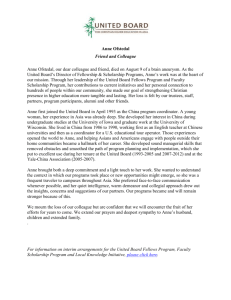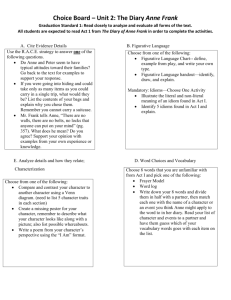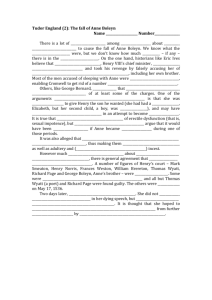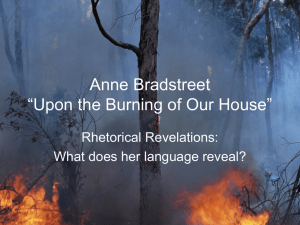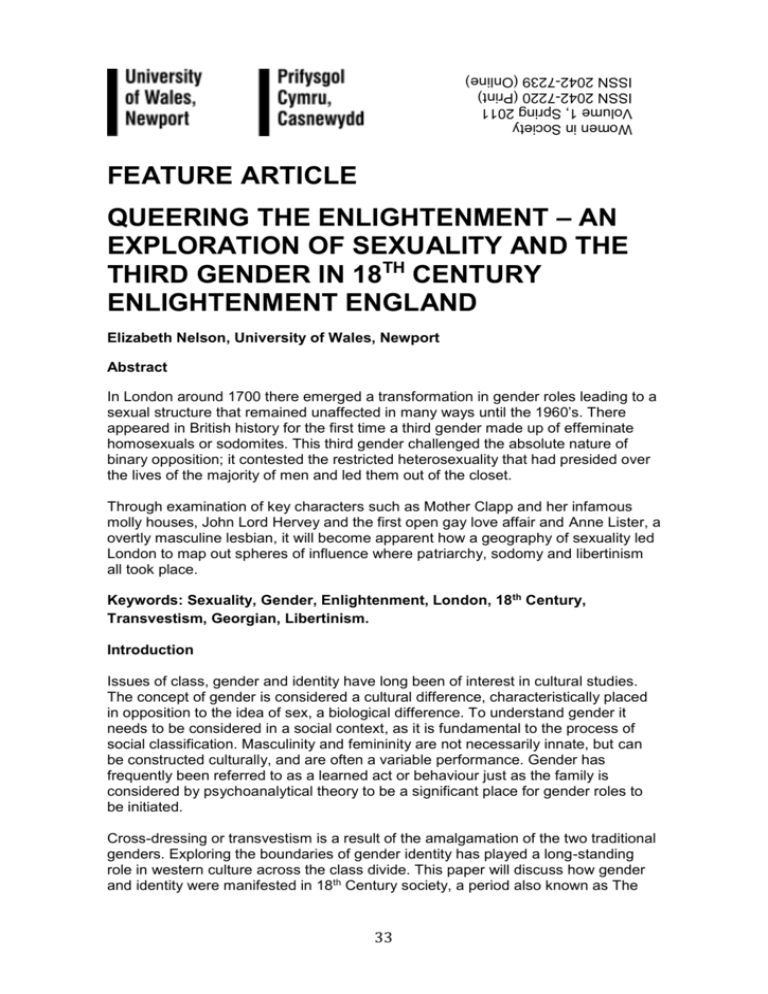
Women in Society
Volume 1, Spring 2011
ISSN 2042-7220 (Print)
ISSN 2042-7239 (Online)
FEATURE ARTICLE
QUEERING THE ENLIGHTENMENT – AN
EXPLORATION OF SEXUALITY AND THE
THIRD GENDER IN 18TH CENTURY
ENLIGHTENMENT ENGLAND
Elizabeth Nelson, University of Wales, Newport
Abstract
In London around 1700 there emerged a transformation in gender roles leading to a
sexual structure that remained unaffected in many ways until the 1960’s. There
appeared in British history for the first time a third gender made up of effeminate
homosexuals or sodomites. This third gender challenged the absolute nature of
binary opposition; it contested the restricted heterosexuality that had presided over
the lives of the majority of men and led them out of the closet.
Through examination of key characters such as Mother Clapp and her infamous
molly houses, John Lord Hervey and the first open gay love affair and Anne Lister, a
overtly masculine lesbian, it will become apparent how a geography of sexuality led
London to map out spheres of influence where patriarchy, sodomy and libertinism
all took place.
Keywords: Sexuality, Gender, Enlightenment, London, 18th Century,
Transvestism, Georgian, Libertinism.
Introduction
Issues of class, gender and identity have long been of interest in cultural studies.
The concept of gender is considered a cultural difference, characteristically placed
in opposition to the idea of sex, a biological difference. To understand gender it
needs to be considered in a social context, as it is fundamental to the process of
social classification. Masculinity and femininity are not necessarily innate, but can
be constructed culturally, and are often a variable performance. Gender has
frequently been referred to as a learned act or behaviour just as the family is
considered by psychoanalytical theory to be a significant place for gender roles to
be initiated.
Cross-dressing or transvestism is a result of the amalgamation of the two traditional
genders. Exploring the boundaries of gender identity has played a long-standing
role in western culture across the class divide. This paper will discuss how gender
and identity were manifested in 18th Century society, a period also known as The
33
Women in Society
Volume 1, Spring 2011
ISSN 2042-7220 (Print)
ISSN 2042-7239 (Online)
Enlightenment. The Enlightenment is often viewed as an anomaly in history, a
transitory moment when a number of philosophers and free thinkers supposed that
the perfect utopian society could be built on intellect and tolerance. However this
promptly crumbled amid the horror of the French Revolution in the late 18th Century.
In London around 1700 there emerged a transformation in gender roles leading to a
sexual structure that remained unaffected in many ways until the 1960’s. There
appeared in British history for the first time a third gender made up of effeminate
homosexuals or sodomites. This third gender challenged the absolute nature of
binary opposition; it contested the restricted heterosexuality that had presided over
the lives of the majority of men and led them out of the closet.
This paper seeks to demonstrate the nature of this sexual revolution. It will include
an introduction into homosexuality and cross-dressing in the 18th century and
observations on the vast differences in the class and gender divide. Key characters
such as Mother Clapp and her infamous molly houses, John Lord Hervey and the
first open gay love affair and Anne Lister, an overtly masculine lesbian will be
observed. Through this, it will become apparent how a geography of sexuality led
London to map out spheres of influence where patriarchy, sodomy and libertinism
all took place.
Sexuality in the 18th Century
Sex was easily accessible to men in London but the spread of sexually transmitted
disease and libertine values fashioned by prostitution were at odds, by the middle of
the century, with ideas of family love and puritan groups such as The Society for the
Reformation of Manners. Women, however, did not have strictly designated
heterosexual identities; a lesbian movement appeared in the 1770s and was mostly
ignored by society. Anne Lister (1791) was one of the first recorded stereotypically
masculine lesbians; women up until then had indulged in sexual passion with their
own kind through social friendships, but had always remained feminine in their
appearance (Whitbread, 1992). Unravelling the ceremony of transvestism within the
homosexual minority should go some way to explaining its position within 18 th
Century society.
For a brief moment during the 18th Century a flamboyant gay scene blossomed in
London. Queen Anne enjoyed dressing up in men’s clothes and was rumoured to
have been a closet queer herself; politics was awash with flamboyantly feminine
gents and working class men could be found in rooms above public houses giving
birth to bizarre and unfortunate objects. Debauchery was rife among the Georgians
(Trumbach, 1998).
From around 1700 there emerged a marginal society of adult males who focussed
their sexual desires solely towards other adult males and pubescent males. Men
such as these were instantly identifiable to their contemporaries by their speech,
mincing gait and natty attire – all of which were effeminate. Despite this, rather than
transforming themselves completely into women, they had combined particular
characteristics of men and women into a third gender. There was also an equivalent
minority of mannish women who solely desired other females, but they did not
34
Women in Society
Volume 1, Spring 2011
ISSN 2042-7220 (Print)
ISSN 2042-7239 (Online)
appear until the 1770’s. Trumbach (1998) thus argues that “…it is therefore the
case that for most of the 18th Century there existed in Northern Europe what might
be described as a system of three genders composed of men, women and
sodomites.”
In the 18th Century this recognition and reorganisation of sexual conduct led, in the
later part of the 19th Century, to the use of the terms homosexual and heterosexual.
These terms were then used to describe a heterosexual majority and a homosexual
minority in sexual behaviour. Before 1700 in European society homosexual
behaviour was structured by age or gender. In Ancient Greece and Renaissance
Italy differences in age structured sexual behaviour; mature men enjoyed sex with
both women and sexually passive young men. In places such as South Asia
traditionally men of all ages would partake in relations with both women and passive
adult males. There was a socialisation of a third gender, the amalgamation of male
and female characteristics had found a dedicated place within society. It is thought
probable that within European society before 1700 the majority of men had feelings
for men and women. These desires were expressed through sex with females and
pubescent males. This model of behaviour had appeared throughout history, from
ancient Greece and Rome right through the Middle Ages (Herdt, 1991).
Rocke’s (1996) research on Renaissance Florence shows that by the age of thirty,
half of Florentine men had been involved in sodomy and by forty years of age, two
thirds had participated in it. Sodomy was therefore a common sexual stance. Age
structured the behavioural patterns of these men; boys were passive from fifteen to
nineteen, between nineteen and twenty-three was an intermediary phase where
they could be passive or active, but with the older man always being active and
after twenty three the men were always active. Most young men also used female
prostitutes up until they married at about thirty years old. Although penetrative sex
with men was against the law and outlawed by the church as immoral, this did not
stop the majority of upper class men, they just kept it well hidden. It was not until the
Restoration period that the brazenness of Lord Rochester was thrust upon
aristocratic society. The notoriously depraved Earl of Rochester wrote the play
Sodom; or the Quintessence of Debauchery in 1684, in which he described sodomy
with boys and women as apathetically depraved and exhilarating: “What tho the
letchery be dry, 'tis smart; A Turkish arse I love with all my heart” (Norton, 2007).
Although Rochester was married, with his wife and children living in Oxfordshire, he
claimed that the devil possessed him once he arrived in London and libertine
traditions became his philosophy. He would sleep with anything - girl, boy, (it is
even rumoured) animal. Yet Rochester and his aristocratic kind moved in an elite
world of proactive bi-sexuality; it was neither flagrant, made public nor condemned
by society. It was the height of hypocrisy.
Mother Clapp
In July 1726 a middle-aged woman with the moniker Mother Clapp was pilloried at
Smithfield’s market; a vociferous mob pelted her with rotten fruit and vegetables,
faeces, mud, decaying offal and dead animals. Did her punishment fit her crime?
She ran one of the most infamous gay bars in London town. According to Norton
35
Women in Society
Volume 1, Spring 2011
ISSN 2042-7220 (Print)
ISSN 2042-7239 (Online)
(2005) she was the earliest recorded example in history of a Fag Hag. Margaret
(Mother) Clapp ran a drinking establishment in Holborn. It is difficult to imagine for a
moment that she was a maternal figure; she was more of a cackling old hag. It is
reported that the men would talk all manner of sickening and gross obscenity in her
hearing and she would be delightfully pleased with it. But her public house was not
just a drinking den; a police informant Samuel Stevens reported a visit he had made
on 14th November 1725 :
I found between 40 and 50 men making love to one another, as they call’d
it. Sometimes they would sit on one another’s laps, kissing in a lewd
manner, and using their hands indecently. Then they would get up, dance
and make curtsies, and mimick the voices of women. O, Fie, Sir! – Pray,
Sir. – Dear Sir. Lord, how can you serve me so? – I swear I’ll cry out. –
You’re a wicked Devil. – And you’re a bold Face. – Eh ye little dear Toad!
Come, buss! – Then they’d hug, and play, and toy, and go out by couples
into another room on the same floor, to be marry’d, as they call’d it. (Norton,
2005)
The police mole claimed to have been disgusted, but he managed to describe in
lurid detail to his senior officers what he had seen. It is mostly because of police
evidence such as this that anything at all is known about 18th Century London’s
escalating gay community.
The public house was just a front; Mother Clapp’s was a ‘molly house’, and her
clientele were known as ‘mollies’. The mollies gave themselves nicknames so as to
mask their true identity; these included Miss Sweet Lips, Plump Nelly, Lady Godiva
and The Princess Seraphina, who was also one of the first recorded drag queens.
This practise also takes place in contemporary society with transvestites and drag
queens giving themselves a stage or character name. According to the historian
Amanda Vickery ‘Molly culture had some similarities with the whole world of drag;
actually I think what it reminds me more of is ‘camp’ really. High octane, theatrical, it
can be sort of selfmocking, but at the same time can be life affirming’ (Marshall,
2003).
The mollies were almost all working or artisan class. They were butchers, bakers,
footmen or waiters, candlestick makers; in other words what would have been
thought of as respectable working class professions. However, what went on in
Mother Clapp’s back room was not considered respectable; it was undeniably a
disorderly house. The back room was called the Chapel or the Marrying Room. The
men would be christened with a woman’s name and a glass of gin would be thrown
into their face at the same time. This was almost certainly designed to mimic how a
baby is anointed during a traditional christening. The men would then come out and
describe to the rest of the mollies what they had been up to. This would include
graphic details of the sexual acts that had taken place, how the other person had
performed and sometimes even their ‘members’ measurements (Vickery, 1998).
Here was the emergence of the modern day homosexual man, gaily skipping into
cultural history. There had been homosexual activity prior to the 18 th Century and
36
Women in Society
Volume 1, Spring 2011
ISSN 2042-7220 (Print)
ISSN 2042-7239 (Online)
some sodomites would probably have been effeminate, but this was not primarily
the case. From the 1660s to the 1730s the number of mollies began to increase and
these effeminate sodomites were becoming visible on the streets of London.
Passes were being made in pissing alleys, public latrines and even theatres,
London’s dark and shady show-grounds. But this behaviour was perilous. In 1533
Henry VIII had made sodomy (which referred to anal intercourse between men, or
sex between a man and animal) crime punishable by death and it remained so until
1861 when the sentence was reduced to 10 years in prison. This did not stop the
practice occurring, but sent it underground. Behaviour such as this would be
considered hazardous even in contemporary society; take the much-publicised case
of George Michael propositioning an off-duty police officer in public toilets in
America. He died a social death by bursting out of the closet in this manner.
Before the 1700s homosexuals were portrayed as predatory beasts stalking
effeminate young men; but at the turn of the century for the first recorded time in
British history, Georgian men felt entitled to a spot of inconspicuous sodomy on the
side. The early 18th Century saw men going to molly houses to dress up in women’s
clothes and meet like-minded gay men, here they pleasured each other and had
sex. This was something new. There was a geographical and a historical reason for
the emergence of the molly at this point in time. The frenzied chaotic capital offered
an array of unconventional identities. London became the centre of the molly culture
in Great Britain. In the 1720s there were 30 molly houses in London; it was not until
the 1960s that there would be more recorded homosexual social establishments in
the city (Trumbach, 1998). Georgian London was teeming with people, lots of whom
had left the countryside because the enclosure of common land meant that farming,
as a means of making a living, was no longer viable. This pattern of migration was
of great cultural importance. The rich and poor were thrown together in a city
surrounded by expanding trade and industry. London became very cosmopolitan
with recognisable minority communities settling in enclaves there. Identities were
lost in the big city, with people becoming confused by whom they were and by
whom they could be; this was not helped by the vast consumption of gin. Historian
Roy Porter (2000) wrote: “Beneath the powdered wig, emotional and psychological
disorder seethed. Beneath the surface of Britain’s cities was an underworld
populated by the poor, the desperate, the criminal and those who refused to
conform.” This is confirmed by Ackroyd’s observation that “the condition of London
itself encourages a life or sense of life, in which contraries meet” (2002).
Life was cruel for London’s unfortunate poor and gin was one of the ways of
numbing the pain. The streets were filthy and only the olfactorily deficient were not
affected by the stench. It has been reported that in 1730 more than 6.6 million
gallons of legally sold gin were consumed; this did not include the illegal liquor sold
from wheelbarrows in the street (Ackroyd, 2002). However, social dislocation
brought new ways of enjoying life, which is where Mother Clapp came in. She did
not just run a brothel, something more peculiar went on upstairs. It has been well
established through court testimony that one man would dress up as a bathycolpian
woman and pretend to give birth. Another man would play the role of the midwife
and would deliver a baby that was usually a doll or sometimes something more
absurd such as a pair of bellows. This pseudo-baby would then be baptised by
37
Women in Society
Volume 1, Spring 2011
ISSN 2042-7220 (Print)
ISSN 2042-7239 (Online)
another molly dressed up as a minister. The meaning of such rituals is still widely
debated. Norton describes the binary opposition of the ceremony: “What they’re
doing essentially is turning on its head the standards and assumptions of
heterosexual society, then consolidating a gay identity as being specifically opposed
to a heterosexual identity” (2005). Norton puts forward a valid point, but perhaps
they were not simply mocking heterosexual customs. This ritual does seems to be a
contemptuous performance of a process that excludes them but it also shows a
wistfulness and longing to be included in a culture that rejects them.
As the molly subculture became more visible, an ominous moral backlash was on
its way. They became social scapegoats for a group founded in 1691 called The
Society for the Reformation of Manners. The latter considered it their moral duty to
stop the sordid behaviour that went on in the streets of London. Historian Amanda
Vickery (1998) describes them as a manic version of the neighbourhood watch,
trying to ‘out’ homosexuals, entrapping and informing on them. It is as a result of
their rise, that the whole Molly culture was exposed. In 1725 the Society besieged
Mother Clapp’s. It appears they hired two young gay hustlers to entrap the mollies
into having sex with them. Then one Sunday night in 1726 the police stormed the
place arresting 40 men dressed up as women and Mother Clapp. Many were
subsequently released through lack of evidence, but two were imprisoned for two
years, two were put in the pillory and the three proved to have committed sodomy
were hanged. Mother Clapp was found guilty of keeping a disorderly house and
condemned to the pillory. She did not survive (Trumbach, 1998).
John Lord Hervey
As the mollies were flushed out of society and driven under ground, working class
homosexual behaviour faded away from chronological record. However, that did not
stop the upper classes carrying on exactly as they pleased. The aristocrats of the
18th Century had always allowed themselves more liberty than they bestowed on
the lower classes. The social elite had inherited libertinism, a hedonistic way of life
allowing them to partake in sexual encounters so long as they were discreet. As
Foucault points out: “underneath the libertine, the pervert” (Foucault, 1979). It was
into this society that John Lord Hervey was brought up. Lord Hervey was rich,
striking, noble and droll; the first recorded historical character to have stereotypical
homosexual attributes (Halsband, 1973). It seems he minced rather than walked
and was always fully made up. His speech was affected and bulimic with French
and Italian phrases; a contemporary caricature of a gay man. Lord Hervey was not
only a successful politician, he was a close friend of Queen Anne and spin-doctor to
Robert Warpole, Prime Minister at the time. He achieved this social standing in
spite of the fact that he was overtly homosexual. One of Hervey’s girlfriends, Lady
Mary Wortley-Montague determined that "the world, consists of men, women, and
Herveys" (Norton, 1998). This serves as an example of the emerging sense of a
third gender; an amusing analogy intuitively expressed by Lady Mary without her
realising its meaning.
Lord Hervey shamelessly flaunted his flamboyance at court. Like the Earl of
Rochester a generation before, he was married and he had eight children. He also
38
Women in Society
Volume 1, Spring 2011
ISSN 2042-7220 (Print)
ISSN 2042-7239 (Online)
had a mistress and a male lover at the same time. It is difficult to picture the
notoriety of flaunting your bisexuality at that level in the House of Lords or House of
Commons today. Hervey did not see himself as different from society because of
his sexuality, although he did presume himself more intelligent, more humorous,
more attractive and more determined (Rousseau, 2002).
In 1726, as the mollies were busily being hounded by the neighbourhood watch,
Lord Hervey was getting fed up with his dazzling but shallow life at court. It was
then he met his nemesis; a heterosexual country boy called Stephen Fox. While
Hervey loved the politics and the pretentious intrigue of court life, Stephen Fox
represented the opposite of this, a safe haven, and he became Hervey’s tonic.
Hervey was soon incapable of disguising his feelings for Stephen Fox. In a letter to
Stephen Hervey wrote:
The favours I have received at Your Honour's Hands are of such a Nature
that tho' the impression might wear out of my Mind, yet they are written in
such lasting characters upon every Limb, that 'tis impossible for me to look
on a Leg or an Arm without having my Memory refresh'd (Norton, 1998).
Although they initially agreed to keep their relationship private, Hervey visibly
blushed when Stephen was around, making their involvement quite obvious.
The turning point of the relationship came when Hervey discarded his wife and
children in the country and embarked on the Grand Tour with Stephen Fox. Whilst
touring they shared a bedroom, which was perceived by others as the innocent
behaviour of a Lord and his man-servant; but for them it was the start of a full blown
love affair. On their return to London fifteen months later Lord Hervey and Stephen
Fox set up home together in Hervey’s Burlington Street mansion. Lady Hervey was
relegated to her in-laws house on her visits to town. This love affair appears to have
been the first fully acknowledged homosexual relationship of the time. However,
with the growing public mood of anxiety that had been inflamed by the lurid trials of
the lower class mollies, Hervey had overstepped the mark (Norton, 1998).
Alexander Pope a caustic satirical writer focussed on Harvey’s homosexuality as a
way of bringing him down. He named him ‘Lord Fanny’ and based his character
‘Sporus’ on Harvey (Hyde 1970). Pope tore apart Harvey’s reputation at court and
soon afterwards he fell from power. Harvey had refused to abide by the code of
public conduct that had allowed the Earl of Rochester to do as he pleased a
generation earlier. He was not just camply dressed and having a sexual relationship
with Stephen; he had fallen in love and it was the aspect of openly loving another
man that was troubling to people. Whilst many of the Georgian aristocracy were
having affairs and behaving licentiously they did so behind closed doors. Hervey’s
ruin came because he was so open about his relationship with Stephen (Murray
1950, Halsband, 1973).
It also appears that Hervey’s obsession with his flagging career was pushing
Stephen away. Stephen was growing up, he had been a very young man when he
met Hervey and as got older he no longer wanted to stand in Hervey's shadow.
Stephen was bored with the responsibility of the increasingly needy, embittered and
39
Women in Society
Volume 1, Spring 2011
ISSN 2042-7220 (Print)
ISSN 2042-7239 (Online)
disillusioned political liability that Hervey had become; so he married. Hervey’s
insecurity and his desperate need to dominate the relationship helped Stephen Fox
fall in love with his wife. Their relationship followed the path of a tragic love story:
Hervey was torn apart by two urges, he wouldn’t give up Stephen for his political
career nor vice versa. In later life, Harvey came across as acidic, malicious, selfpitying and vain. His saving grace was that he had refused to hide in the closet
choosing instead to declare his love to the world. When he died in 1743 it would be
another two hundred and fifty years before there would be another openly
homosexual politician in Britain (Murray, 1950, Halsband, 1973).
As the ideas of enlightenment, liberty and individuality bridged the class boundaries
of Georgian society it appeared that every man, whatever his social standing, could
become whatever he wanted to be. Where women were concerned no one really
cared if they were in love with each other and men found it hard to imagine them
having sexual relations. The pornographic novel ‘Fanny Hill’ was published in 1749
and was a bestseller. It established a theme much in favour with pornographers
ever since; women making love to women - aimed solely at the heterosexual male
market. The story followed country girl Fanny Hill to London where she ended up in
a brothel. The brothel had to ensure that Fanny was mature enough for sex with
men so prostitute Phoebe ascertained this by making love to her. However, this
doesn’t turn Fanny into a lesbian, it just makes her ready for sex with men (Cleland,
2002)
In the 18th Century sex meant penetration. Most men could not conceive of sex
between two women because there was no penetration involved; therefore
according to the laws on sodomy it was not technically illegal. Aristocratic 18th
Century women married their social equal. Marriage was a union between two
families with dynasty and money coming before love and emotion. This meant that it
was usually an unsentimental affair, so it was not surprising that Georgian women
entered passionate relationships with each other. Men had no interest in the
emotional or intellectual side of women, so the women amused themselves. When it
occasionally spilt over into a physical manifestation it was thought amusing but it
was not a vice in the way that male homosexuality was.
Anne Lister
The attitude towards female sexual relationship described above may have
remained unaltered, but for the discovery in 1988 of an astonishing set of diaries.
The secret diaries of Yorkshire landowner Anne Lister were unearthed after over
100 years behind a bookcase at the Lister ancestral home; Shibden Hall, near
Halifax. Anne Lister’s sexually explicit accounts turned around the idea of purely
romantic friendship constituting Georgian saphist history. Anne Lister appears to
have had her way with many of the highly reputable women of her day. Born into a
gentile Yorkshire family in 1791 Anne Lister inherited Shibden Hall from her Uncle
and became financially independent. All of Anne’s childhood friends had married but
Anne knew that was not what she wanted. From a young age Anne was aware that
she only had feelings for women, that she was a saphist, and that was what God
had intended for her. Know locally as an eccentric figure, she considered herself to
40
Women in Society
Volume 1, Spring 2011
ISSN 2042-7220 (Print)
ISSN 2042-7239 (Online)
be a masculine oddity; modern society may describe her as having been butch.
Anne Lister conformed to the manly lesbian stereotype; she wore masculine
clothes, smoked a pipe and went fishing, shooting and hare coursing. Anne
appeared to be a very successful seducer; she used her social status to impress
and deployed her knowledge of women against them. She made a conscious effort
not to appear overtly mannish, but tried to address the women in a soft and
chivalrous manner. She twirled her fob watch and flattered them into submission
(Vickery, 1998).
In 1832 Anne Lister met her soul mate. Neighbouring heiress Anne Walker was
young, attractive and unmarried; she was also in awe of the older Anne. This
relationship was not just another flirtation for Anne Lister, she was determined that it
was going to last. It is reported that on the 4th October 1832 the two had dinner;
Anne Walker wore an evening gown, an appreciated feminine touch, and this
culminated in Anne Lister making the diary entry below:
‘she sat on my knee and I did not spare kissing and pressing, she returning
it’…then…’finding no resistance and lamp being out, let my hand wander
lower down gently getting to her queer, still no resistance so I whispered
‘surely she should care for me some little’ the reply ‘yes’ (Marshall, 2003).
Her diaries exposed an aspect of female relationships never explored by Jane
Austen. Anne Lister did not want to settle for someone beneath her social status so
playing the role of a gentleman entailed seeking a match that combined romance
and practicality; later that year Anne Walker moved into Shibden Hall. Unlike Lord
Harvey and Stephen Fox’s coupling, people talked about the two Anne’s but were
easily persuaded to accept two gentrified landowners living under one roof. Mainly
because she was a woman, Anne Lister was getting away with what Lord Harvey
could not. Her sexual situation was also helped by geography; she was an heiress
but she lived in a solitary house on a hill in Yorkshire, rather than at the prominent
London address of Lord Harvey. Country folk would have had no experience of
homosexuality and therefore would have no reason to assume that the living
arrangements of the two women were anything other than innocent. Anne Lister’s
masculine attire was most probably put down to her having to run the family estate;
with no male family member or spouse available to manage the tenants, she would
have had to have spent time on the land. A passage from the diaries revealed that
the two Annes, in an attempt to conform to gender roles and societal norms,
engaged in an unorthodox wedding ceremony:
Miss Walker told me in the hut that if she said ‘yes’ again it should be
binding, it should be the same as a marriage and she would give me no
cause to be jealous, made no objection to declaring it on the bible and
taking the sacrament with me at Shibden (Marshall, 2003).
Anne Lister died 6 years after their ‘marriage’. The unfortunate Anne Walker didn’t
get to enjoy her inheritance for long; she was committed to a mental institution by
her calculating relatives who discovered the lesbian relationship and proclaimed her
to be mad (Vickery, 1998).
41
Women in Society
Volume 1, Spring 2011
ISSN 2042-7220 (Print)
ISSN 2042-7239 (Online)
The Gender Closet
Gender can be considered a performance with no foundation in sexual preference
or identity. Female impersonation, beginning with the mollies of the 18 th Century,
has long had psychoanalytical links with femininity and the masquerade
(Ruitenbeek, 1966). Freud arguds that some reactions stem from the unconscious
and that the unconscious is created when drives and instincts are disciplined by
social rules or cultural values (Rose, 2001).
Psychoanalytical concepts can be used to examine the cross dressing practises
that took place in the 18th Century; in particular the role of the molly and masculine
saphist. Alongside other conventional binaries the theoretical aversion between a
heterosexual and a homosexual identity is based around sexual boundaries.
Crossing these boundaries has become thought of as a tactic for the subversion of
gender and identity. Transvestism is largely considered to be a sexual obsession;
and has often been the expression of social or political dissent. Ackroyd suggests
that:
It is a persistent and universal activity; it exists wherever sexual behaviour
itself exists, perhaps lying dormant in most human beings; and it is to be
found in most cultures and across many centuries. But it still remains
inexplicable: why is there this repeated need for inversion and disorder?
(Ackroyd, 1979)
If a transvestite wants to be identified as a woman and we take that woman to be
the mother figure then the wearing of women’s clothes helps to re-create the bond
with the mother enjoyed as a child. Dressing up reunites the transvestite with the
representation of his mother; some take things further and actually aspire to
‘maternal happiness’ (Hirschfield, 1979). This has led to certain transvestites posing
as pregnant women and although this theory does not come into play until the 20 th
Century, the 18th Century rituals of the mollies suggests that it has been in
existence for almost three hundred years. As explained earlier, the mollies actually
took the role-play a step further by simulating the birth of a baby. In a more literal
sense Mother Clapp, catalyst for the mollies behaviour, becomes the mother figure
in the scenario: the mollies incongruously trying to become female in her likeness.
Cross-dressing visualises masculinity and femininity in ways that empowers and
disempowers women. For Anne Lister in the 18th Century, dressing as a man was
mostly ignored by society. There is very little literature available discussing the topic
and this may be because male clothing has no erotic value and was not therefore
considered sexually threatening. Lesbian cross-dressing could be a way of
asserting power in a patriarchal society that limits the societal standing of women.
Freud stated that:
…little girls notice the penis of a brother or playmate, strikingly visible and
of large proportions, at once recognise it as the superior counterpart of their
own small and inconspicuous organ, and from that time fall a victim to envy
for that penis (Richardson, 1996).
42
Women in Society
Volume 1, Spring 2011
ISSN 2042-7220 (Print)
ISSN 2042-7239 (Online)
It could be said that Anne Lister was suffering from penis envy. She dressed and
acted in a masculine fashion not to impersonate a man but to seize the power
associated with the phallus. Frank Caprio substantiates this with his claim that:
Many lesbian relationships between two women become the equivalent of a
husband-wife relationship. The mannish or overt lesbian likes to take on the role of
the ‘husband’ and generally attaches herself to the female partner who is feminine
in physique and personality. She regards the mate as her ‘wife’ (Caprio, 1954).
It is easy to imagine from the diaries that the relationship between Anne Lister and
Anne Walker was as such. Anne Lister describes herself in the husbandly role,
sitting reading a newspaper or catching up with estate business while Anne Walker
does some sewing or painting. It is a gendered view of an unorthodox marriage.
The emulating effect of transvestism has a communicative role to play; it is perhaps
an expression of the intention of its bearer to consciously undertake the role of
opposing gender.
Conclusion
When Anne Lister died in 1840, Queen Victoria was on the throne and the
hedonistic Georgian age was over: an age of experimentation, where England
appears to have let its hair down and felt the first awakenings of a conspicuously
gay culture. It was a tentative era, where ideas about what makes you who you are,
were more individual and adaptable than they can sometimes be today. It seems
that the upper classes and the aristocracy had always had the privacy and
autonomy to be sexually alternative in their choices, tolerating bisexuality.
The resettlement of so many poorer country folk to London, where their behaviour
was not scrutinised, observed or inhibited by their families and peers, enabled the
lower classes to experiment with their sexuality, thus identifying the importance of
geography in terms of sexuality. The press exposure of molly culture increased
homophobia, yet at the same time paradoxically publicised the gay community. If
you lived in Manchester in the 1720s and you harboured secret feelings for men you
might read the newspapers and as a result make your way to London. On the other
hand as the newspapers stories gathered momentum, there was an up-roar of
moral panic. People feared that given half the chance any man might engage in
sodomitical liaisons; falling foul of male lust. This encouraged the press to whip up
public fury. In May 1726 the London Journal demanded drastic action against any
molly caught:
Common Hangman tie him Hand and Foot before the Judge’s Face in open
Court, that a Skillful Surgeon be provided immediately to take out his
Testicles, and that then the Hangman sear up his Scrotum with an hot Iron
(Norton, 2005).
Sexual difference traverses an array of cultural and historical contexts. According to
Goffman gender refers to the culturally established correlates of sex (Ekins, 1996).
It can be determined by you or by others depending on social constraints, and is an
essential component in the presentation of yourself to the world. Sexual identity is
43
Women in Society
Volume 1, Spring 2011
ISSN 2042-7220 (Print)
ISSN 2042-7239 (Online)
encoded by gender. The majority of us are either male or female, perhaps an
uncomplicated way to begin. Difficulties arise when we start to understand that male
and female mean different things to different people. How we live, observe, and
relate to our peers depends in part on how we empathise with each others’
masculinity or femininity. These meanings are subconsciously significant in
everybody’s lives; within society, politically and sexually. As connotations range
from the superficial to the extremely complex, issues of gender have always carried
great potential for disagreement.
The idea of a third gender seemed to emerge with Lady Mary Wortley-Montague’s
opinion of Lord Hervey in the 1730s as being neither definitively male nor female.
There have been cultures where transvestism has been institutionalised with the
cross-dresser given common standing as an honorary third gender. Perhaps then
clothing or dress becomes the agenda, expressing the underlying social structures
of class, gender and identity. Dress does have a communicative role to play yet it is
unstable and conflicting in its portrayal. The emulating effect of transvestism is an
expression of the intention of its bearer to consciously undertake the role of the
opposing gender. The Georgians undertook the view that whom you have sex with
defined you as a person, a viewpoint also held in contemporary society. It appears
however, that during the 18th Century people possessed a keen sense of having
multiple roles to play and did so mostly without remorse.
REFERENCES
Abelore, H., Barale, M.A and Halperin, D.M. (Eds) 1993. The Lesbian and Gay
Studies Reader. New York: Routledge.
Ackroyd, P. 2002. Albion – The Origins of the English Imagination. London: Chatto
& Windus.
Ackroyd, P. 1979. Dressing Up – Transvestism and Drag: The History of an
Obsession. London: Thames & Hudson.
Ackroyd, P. 2001, London - The Biography. London: Vintage.
Butler, J. 1999. Gender Trouble – Feminism and the Subversion of Identity. New
York and London: Routledge.
Butler, J. 1991. Imitation and Gender Insubordination. In Fuss, D. Ed. Inside/Out –
Lesbian Theories, Gay Theories. New York: Routledge. pp 13-32.
Capiro, F. 1954. Female Homosexuality: A Psychodynamic Study of Lesbianism.
New York: Citadel Press.
Chadwick, W. 1996. Women Art & Society, 2nd edn. London: Thames & Hudson.
Cleland, J. 2003. (New edition) Fanny Hill: Or Memoirs of a Woman of Pleasure.
England: Wordsworth.
44
Women in Society
Volume 1, Spring 2011
ISSN 2042-7220 (Print)
ISSN 2042-7239 (Online)
Creekmur, C. K. and Doty, A. Eds. 1995. Out in Culture – Gay, Lesbian, and Queer
Essays on Popular Culture. London: Cassell.
David, H. 1997. On Queer Street – A social History of British Homosexuality 18951995. London: Harper & Collins.
Doty, A. 1993. Making Things Perfectly Queer – Interpreting Mass Culture.
Minneapolis and London: University of Minnesota Press.
Edgar, A. Sedgwick, P. Eds. 1991. Key Concepts in Cultural Theory. London and
New York: Routledge.
Ekins, R. 1997. Male Femaling – A grounded Theory Approach to Cross Dressing
and Sex Changing. London and New York: Routledge.
Ekins, R. King, D. Eds. 1996. Blending Genders – Social Aspects of Cross-Dressing
and Sex-Changing. London and New York: Routledge.
Eldeman, L. 1991. Seeing Things: Representation, the Scene of Surveillance, and
the Spectacle of Gay Male Sex. In FUSS, D. Ed Inside/Out– Lesbian Theories, Gay
Theories. New York: Routledge, pp 71-93.
Foucault, M. 1979. The History of Sexuality – An Introduction. Great Britain: Allen
Lane.
Hallett, M. 1991. The Spectacle of Difference – Graphic Satire in the Age of
Hogarth. New Haven & London: Yale University Press.
Halsband, R. 1973. Lord Hervey: Eighteenth-Century courtier. Oxford: Clarendon
Press.
Horne, P. Lewis, R. (Eds.) 1996. Outlooks: Lesbian and Gay Sexualities and Visual
Culture. New York: Routledge.
Hyde, M. H. 1970. The Other Love: An Historical and Contemporary Survey of
Homosexuality In Britain. London: Heinemann.
Kellwe, W. Holzworth, H.W. 1994. A Double Life. New York: Scalo Publishers.
Marshall, J. 2003. Queer as 18th Century Folk. [off-air video recording: DVD]
Channel 4. 9th Dec 2003.
Morton, D, Ed. 1997. A LesBiGay Cultural Studies Reader. London: Westview
Press.
Murray, J. Ed. 1950. Lord Hervey and His Friends 1726–38, ed. the Earl of
Ilchester. [online book] London.
45
Women in Society
Volume 1, Spring 2011
ISSN 2042-7220 (Print)
ISSN 2042-7239 (Online)
http://openlibrary.org/books/OL6087992M/Lord_Hervey_and_his_friends_1726-38
(2nd February 2011)
Norton, R. 1998 updated 2007. England's First Pornographer, A History of
Homoerotica. [online essay] http://rictornorton.co.uk/wilmot.htm (2nd February
2011)
Norton, R. 2005. Mother Clap's Molly House, The Gay Subculture in Georgian
England [online essay] http://rictornorton.co.uk/eighteen/mother.htm (2nd February
2011)
Norton, R. Ed. 1998. Town and Country The Gay Love Letters of John, Lord Hervey
to Stephen Fox. Excerpts from My Dear Boy: Gay Love Letters through the
Centurie. [online essay] http://rictornorton.co.uk/hervey1.htm (2nd February 2011)
Porter, R. 2000. (new edition) London: A Social History. Penguin.
Richardson, D. (Ed.) 1996. Theorising Heterosexuality – Telling it Straight.
Buckingham and Philadelphia: Open University Press.
Riviere, J. 1966. Womanliness as a masquerade. In, Ruitenbeek, H. M. (Ed.)
Psychoanalysis and Female Sexuality. New Haven: College and University Press,
pp 209-220.
Rose, G. 2001. Visual Methodologies – An Introduction to the interpretation of
Visual Methods. London: Sage.
Rousseau, G. S. 2004. English Literature: Restoration and Eighteenth Century. In
Summers, C.J. An Encyclopaedia of Gay, Lesbian, Bisexual, Transgender & Queer
Culture. [online book].
http://www.glbtq.com/literature/eng_lit4_restoration_18c.html (2nd February 2011)
Sedgwick, E. K. 1990. Epistemology of the Closet. Berkeley, Los Angeles:
University of California Press.
Smart, C. 1996. Collusion, Collaboration and Confessions. In Richardson, D. (Ed.)
Theorising Heterosexuality – Telling it Straight. Buckingham and Philadelphia: Open
University Press.
Trumbach, R. 1998 Sex and the Gender Revolution Volume 1 – Heterosexuality
and the Third Gender in Enlightenment London. Chicago & London: The University
of Chicago Press.
Vickery, A. 2003 (new edition). The Gentleman's Daughter: Women's Lives in
Georgian England. Yale: Yale University Press.
Whitbread, H. Ed. 1992. I Know My Own Heart: The Diaries of Anne Lister, 17911840 (Cutting edge lesbian life & literature). New York: New York University Press.
46


